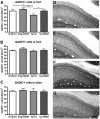α-Melanocyte stimulating hormone prevents GABAergic neuronal loss and improves cognitive function in Alzheimer's disease
- PMID: 24828629
- PMCID: PMC6608113
- DOI: 10.1523/JNEUROSCI.5075-13.2014
α-Melanocyte stimulating hormone prevents GABAergic neuronal loss and improves cognitive function in Alzheimer's disease
Abstract
In Alzheimer's disease (AD), appropriate excitatory-inhibitory balance required for memory formation is impaired. Our objective was to elucidate deficits in the inhibitory GABAergic system in the TgCRND8 mouse model of AD to establish a link between GABAergic dysfunction and cognitive function. We sought to determine whether the neuroprotective peptide α-melanocyte stimulating hormone (α-MSH) attenuates GABAergic loss and thus improves cognition. TgCRND8 mice with established β-amyloid peptide pathology and nontransgenic littermates were treated with either α-MSH or vehicle via daily intraperitoneal injections for 28 d. TgCRND8 mice exhibited spatial memory deficits and altered anxiety that were rescued after α-MSH treatment. The expression of GABAergic marker glutamic acid decarboxylase 67 (GAD67) and the number of GABAergic GAD67+ interneurons expressing neuropeptide Y and somatostatin are reduced in the hippocampus in vehicle-treated TgCRND8 mice. In the septohippocampal pathway, GABAergic deficits are observed before cholinergic deficits, suggesting that GABAergic loss may underlie behavior deficits in vehicle-treated TgCRND8 mice. α-MSH preserves GAD67 expression and prevents loss of the somatostatin-expressing subtype of GABAergic GAD67+ inhibitory interneurons. Without decreasing β-amyloid peptide load in the brain, α-MSH improves spatial memory in TgCRND8 mice and prevents alterations in anxiety. α-MSH modulated the excitatory-inhibitory balance in the brain by restoring GABAergic inhibition and, as a result, improved cognition in TgCRND8 mice.
Keywords: Alzheimer's disease; GABAergic system; cognitive function; somatostatin; α-melanocyte stimulating hormone.
Copyright © 2014 the authors 0270-6474/14/336736-10$15.00/0.
Figures







Similar articles
-
α-Melanocyte Stimulating Hormone as a Potential Therapy for Alzheimer`s Disease.Curr Alzheimer Res. 2017;14(1):18-29. doi: 10.2174/1567205013666160819130641. Curr Alzheimer Res. 2017. PMID: 27539595 Review.
-
Memory-enhancing and brain protein expression-stimulating effects of novel calcium antagonist in Alzheimer's disease transgenic female mice.Pharmacol Res. 2016 Nov;113(Pt B):781-787. doi: 10.1016/j.phrs.2016.06.020. Epub 2016 Jun 21. Pharmacol Res. 2016. PMID: 27345857 Free PMC article.
-
Isorhynchophylline ameliorates cognitive impairment via modulating amyloid pathology, tau hyperphosphorylation and neuroinflammation: Studies in a transgenic mouse model of Alzheimer's disease.Brain Behav Immun. 2019 Nov;82:264-278. doi: 10.1016/j.bbi.2019.08.194. Epub 2019 Aug 30. Brain Behav Immun. 2019. PMID: 31476414
-
Hippocampal GABAergic neurons are susceptible to amyloid-β toxicity in vitro and are decreased in number in the Alzheimer's disease TgCRND8 mouse model.J Alzheimers Dis. 2012;29(2):293-308. doi: 10.3233/JAD-2011-110830. J Alzheimers Dis. 2012. PMID: 22232004
-
GABAergic dysfunction, neural network hyperactivity and memory impairments in human aging and Alzheimer's disease.Semin Cell Dev Biol. 2021 Aug;116:146-159. doi: 10.1016/j.semcdb.2021.01.005. Epub 2021 Feb 9. Semin Cell Dev Biol. 2021. PMID: 33573856 Free PMC article. Review.
Cited by
-
Genetic induction of hypometabolism by ablation of MC4R does not suppress ALS-like phenotypes in the G93A mutant SOD1 mouse model.Sci Rep. 2017 Oct 13;7(1):13150. doi: 10.1038/s41598-017-13304-4. Sci Rep. 2017. PMID: 29030576 Free PMC article.
-
Differential regulation of gene expression pathways with dexamethasone and ACTH after early life seizures.Neurobiol Dis. 2022 Nov;174:105873. doi: 10.1016/j.nbd.2022.105873. Epub 2022 Sep 21. Neurobiol Dis. 2022. PMID: 36152945 Free PMC article.
-
Investigation of the effect of α-melanocyte-stimulating hormone on proliferation and early stages of differentiation of human induced pluripotent stem cells.Dokl Biochem Biophys. 2016 Mar;467(1):141-4. doi: 10.1134/S1607672916020174. Epub 2016 May 20. Dokl Biochem Biophys. 2016. PMID: 27193719
-
Identification of Alzheimer's disease-associated rare coding variants in the ECE2 gene.JCI Insight. 2020 Feb 27;5(4):e135119. doi: 10.1172/jci.insight.135119. JCI Insight. 2020. PMID: 32102983 Free PMC article.
-
Neuroprotective Effects of Lycium barbarum Berry on Neurobehavioral Changes and Neuronal Loss in the Hippocampus of Mice Exposed to Acute Ionizing Radiation.Dose Response. 2021 Nov 26;19(4):15593258211057768. doi: 10.1177/15593258211057768. eCollection 2021 Oct-Dec. Dose Response. 2021. PMID: 34887716 Free PMC article.
References
-
- Andrews-Zwilling Y, Bien-Ly N, Xu Q, Li G, Bernardo A, Yoon SY, Zwilling D, Yan TX, Chen L, Huang Y. Apolipoprotein E4 causes age- and Tau-dependent impairment of GABAergic interneurons, leading to learning and memory deficits in mice. J Neurosci. 2010;30:13707–13717. doi: 10.1523/JNEUROSCI.4040-10.2010. - DOI - PMC - PubMed
-
- Arai H, Moroji T, Kosaka K, Iizuka R. Extrahypophyseal distribution of alpha-melanocyte stimulating hormone (alpha-MSH)-like immunoreactivity in postmortem brains from normal subjects and Alzheimer-type dementia patients. Brain Res. 1986;377:305–310. doi: 10.1016/0006-8993(86)90873-5. - DOI - PubMed
Publication types
MeSH terms
Substances
Grants and funding
LinkOut - more resources
Full Text Sources
Other Literature Sources
Medical
Molecular Biology Databases
